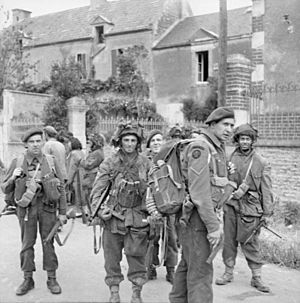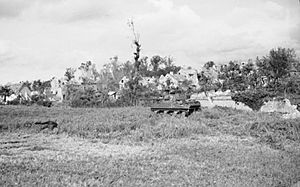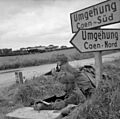Battle of Bréville facts for kids
Quick facts for kids Battle of Bréville |
|||||||
|---|---|---|---|---|---|---|---|
| Part of Operation Overlord | |||||||
 British Parachute and Commando troops in Normandy, June 1944 |
|||||||
|
|||||||
| Belligerents | |||||||
| Commanders and leaders | |||||||
| Units involved | |||||||
| 6th Airborne Division | 346th Infantry Division | ||||||
| Casualties and losses | |||||||
| 162 Dead ^ | Over 400 confirmed dead | ||||||
| ^ Numbers for the final attack 12 June | |||||||
The Battle of Bréville was an important fight during the early days of the invasion of Normandy in World War II. It took place between 8 and 13 June 1944. British soldiers from the 6th Airborne Division fought against German troops from the 346th Infantry Division.
The battle happened in and around Bréville-les-Monts, a small village in France. This village was on high ground, like a hill, which gave the Germans a great view. From there, they could see the British positions, including the important bridges over the Orne River and Caen Canal. They could also see Sword Beach, where British troops had landed on D-Day.
The Germans used this high ground to attack the British. Because of these attacks, it became super important for the British to capture Bréville. Taking the village would help protect the British landing area and keep their D-Day plans safe.
The main British attack happened on the night of 12/13 June 1944. Major-General Richard Nelson Gale sent his last reserve troops into the fight. These included the 12th (Yorkshire) Parachute Battalion and other units. Tanks and many artillery guns helped support the attack.
The fight was very tough, with both British and German artillery firing. Many soldiers were hurt or killed, even some high-ranking officers. But the British troops kept going and finally captured the village. After Bréville was taken, the Germans stopped trying to break through the British lines in that area. This victory helped secure the left side of the Allied invasion zone in Normandy.
Why Bréville Was Important
Securing the D-Day Landing Zone
On 6 June 1944, known as D-Day, the 6th Airborne Division landed in Normandy. Their main job was to protect the left side of the British landing area. They had to capture two key bridges, destroy a big German gun battery, and blow up other bridges to stop German reinforcements.
The paratroopers landed by parachute, but many were scattered. Still, they managed to complete their missions. Later that day, more troops arrived by gliders to help them.
Facing German Counter-Attacks
After D-Day, the 6th Airborne Division had to defend the area around the Orne River bridges. This was a big challenge because they faced strong German forces. These included the 21st Panzer Division from the south and two infantry divisions from the east.
The British set up their defenses along a ridge of high ground. If the Germans took this ridge, they could easily see and attack the British positions, including the landing zones.
The Gap in the Line
However, the British defense line wasn't complete. The small village of Bréville-les-Monts was still held by the Germans. It was right on the ridge, between two British brigades. This meant the Germans in Bréville could look down on the British headquarters in Ranville, the captured bridges, and even Sword Beach. This made Bréville a dangerous spot for the British.
The Battle for Bréville
Early Skirmishes: 7-8 June
On 7 June, a small group of British paratroopers, the 9th Parachute Battalion, marched through Bréville. They found it empty at first. They then dug in to defend an area near the village. However, there was a big gap between them and another British unit, No. 6 Commando.
German forces from the 346th Infantry Division soon arrived. They attacked the British commandos, but the commandos fought back hard. Later, No. 6 Commando attacked Bréville itself, clearing out some Germans and capturing weapons. But they then pulled back, and the Germans quickly reoccupied the village. This left the 9th Parachute Battalion almost cut off.
The Germans then started attacking the 9th Parachute Battalion. These were mostly small attacks at first, but they showed the Germans were getting stronger.
Intense Fighting: 9-10 June
On 9 June, the Germans launched a heavy mortar attack on the 9th Parachute Battalion. They attacked the British positions several times, but the paratroopers fought them off. At one point, a group of Germans tried to sneak through the woods. The British commander, Lieutenant Colonel Terence Otway, gathered his men and trapped the Germans, defeating them.
On 10 June, British patrols saw many Germans gathering in Bréville, expecting a big attack. And they were right! A huge artillery and mortar bombardment hit the British lines. The Germans attacked the commandos and other British units. The fighting was very fierce, with hand-to-hand combat in some places.
The Germans also attacked the 5th Parachute Brigade. British soldiers waited until the Germans were very close before opening fire, causing many German casualties. The 9th Parachute Battalion also faced strong attacks, including one with tanks and armored vehicles. The British used their anti-tank weapons to fight back.
Major General Richard Nelson Gale realized his troops were under a lot of pressure. He asked for tank support to help clear out German positions. In one fight, British tanks and paratroopers worked together to push the Germans out of a wooded area.
Because of the heavy fighting, more British troops were sent to help the 6th Airborne Division. The 5th Battalion Black Watch was ordered to prepare for an attack to capture Bréville.
The Black Watch Attack: 11 June
On 11 June, the Black Watch battalion attacked Bréville. They had to cross a wide-open field to reach the village. As they got closer, the British artillery stopped firing, and the Germans opened up with everything they had. One company of soldiers was completely wiped out by German machine-gun fire.
The attack failed, and the Black Watch suffered many casualties. The survivors pulled back. Later, British tanks tried to help, but German self-propelled guns destroyed some of them, and the rest couldn't move well in the woods. The day ended without further attacks, but the Germans were clearly getting ready for more fighting.
The Final Push: 12-13 June
On 12 June, the Germans launched another major attack. They hit the Canadian and British paratroopers with infantry, tanks, and self-propelled guns. The fighting was very intense, especially around the Château (a large house) in Bréville. The Black Watch and 9th Parachute Battalion were pushed back.
The situation was critical. The British commander, Otway, told headquarters they couldn't hold out much longer. Brigadier James Hill personally led a counter-attack with forty Canadian soldiers, pushing the Germans back and restoring the line.
The Night Attack on Bréville
To finally end the German threat, General Gale decided they had to take Bréville. He used his last reserve troops for a night attack. These included the 12th Parachute Battalion and a company from the 12th Battalion, Devonshire Regiment. Tanks and many artillery guns were ready to support them. The attack was planned for 10:00 PM, hoping to catch the Germans tired.
The attack began with British artillery fire, and the Germans fired back. The British troops had to cross a long open field under heavy fire. Many officers and sergeants were killed or wounded. For example, in 'C' Company, all the officers and the company sergeant major were hit, and a brave non-commissioned officer named Edmund Warren took command. Only fifteen survivors from that company reached the village.
The Devonshire company also suffered heavy losses. Their commander and the overall attack commander, Lieutenant Colonel Johnny Johnson, were killed by a single shell. Another officer, Colonel Reginald Parker, took over.
By 10:45 PM, the remaining British soldiers had secured their objectives in the village. The shelling stopped, and 'B' Company reached the village without a fight. But fearing a German counter-attack, Parker ordered more artillery fire. However, there was a mistake, and the artillery accidentally shelled the British positions in the village, causing more casualties.
Finally, at 2:00 AM on 13 June, British tanks and more paratroopers arrived. Bréville was now firmly in British hands. The 1st Battalion Royal Ulster Rifles then moved into the village to take over from the exhausted survivors.
After the Battle
The final attack on Bréville was very costly for the British. The 12th (Yorkshire) Parachute Battalion lost 126 men killed, and its fighting companies were left with only a few soldiers. The Devonshire company also lost many men. Every officer or senior non-commissioned officer who took part in the attack was either killed or wounded. The German defenders also suffered huge losses.
But the battle was a big success. The left side of the D-Day invasion area was now safe. The Germans never tried another serious attack on the British airborne division after this. The Battle of Bréville was a crucial victory that helped secure the Allied position in Normandy. It is remembered as one of the most important battles of the invasion.
Images for kids





